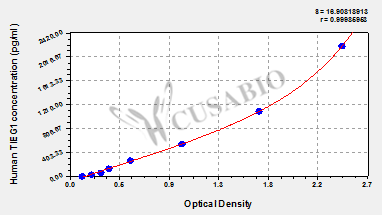| Code | CSB-E09186h |
| Size | 96T,5×96T,10×96T |
| Price | Request a Quote or Start an on-line Chat |
| Trial Size |
24T ELISA Kit Trial Size (Only USD$150/ kit) * The sample kit cost can be deducted from your subsequent orders of 96T full size kits of the same analyte at 1/5 per kit, until depleted in 6 months. Apply now |
| Intra-assay Precision (Precision within an assay): CV%<8% | |||||||
| Three samples of known concentration were tested twenty times on one plate to assess. | |||||||
| Inter-assay Precision (Precision between assays): CV%<10% | |||||||
| Three samples of known concentration were tested in twenty assays to assess. | |||||||
| To assess the linearity of the assay, samples were spiked with high concentrations of human TIEG1 in various matrices and diluted with the Sample Diluent to produce samples with values within the dynamic range of the assay. | |||||||
| Sample | Serum(n=4) | ||||||
| 1:1 | Average % | 85 | |||||
| Range % | 81-89 | ||||||
| 1:2 | Average % | 93 | |||||
| Range % | 90-96 | ||||||
| 1:4 | Average % | 84 | |||||
| Range % | 81-86 | ||||||
| 1:8 | Average % | 95 | |||||
| Range % | 91-99 | ||||||
| The recovery of human TIEG1 spiked to levels throughout the range of the assay in various matrices was evaluated. Samples were diluted prior to assay as directed in the Sample Preparation section. | |||||||
| Sample Type | Average % Recovery | Range | |||||
| Serum (n=5) | 103 | 100-105 | |||||
| EDTA plasma (n=4) | 98 | 94-102 | |||||
| These standard curves are provided for demonstration only. A standard curve should be generated for each set of samples assayed. | ||||||||||||||||||||||||||||||||||||||||||||||||||||||||||||||||||||||||

| ||||||||||||||||||||||||||||||||||||||||||||||||||||||||||||||||||||||||
The human TIEG1 Elisa kit is suitable for the quantitative measurement of human TIEG1 in serum, plasma, tissue homogenates, or cell lysates. This assay employs the sandwich enzyme immunoassay technique and enzyme-substrate chromogenic reaction. The color develops positively to the amount of human TIEG1 in samples. The color development is stopped and the intensity of the color is measured. This kit displays many advantages, including high sensitivity, strong specificity, good linearity, high precision and recovery, as well as lot-to-lot consistency.
TIEG1, also known as KLF10, is inducibly expressed by TGF-β, bone morphogenetic proteins (BMPs), and other cytokines. It is expressed in specific cell types in numerous tissues and is involved in inhibiting cell proliferation and inflammation as well as inducing apoptosis similar to that of TGFβ. TIEG1 binds to Sp-1-GC-rich DNA sequences and can activate or suppress the transcription of numerous genes. TIEG1 also plays an important role in regulating cell apoptosis and proliferation in various diseases, including pancreatic cancer, leukemia, and osteoporosis.
There are currently no reviews for this product.